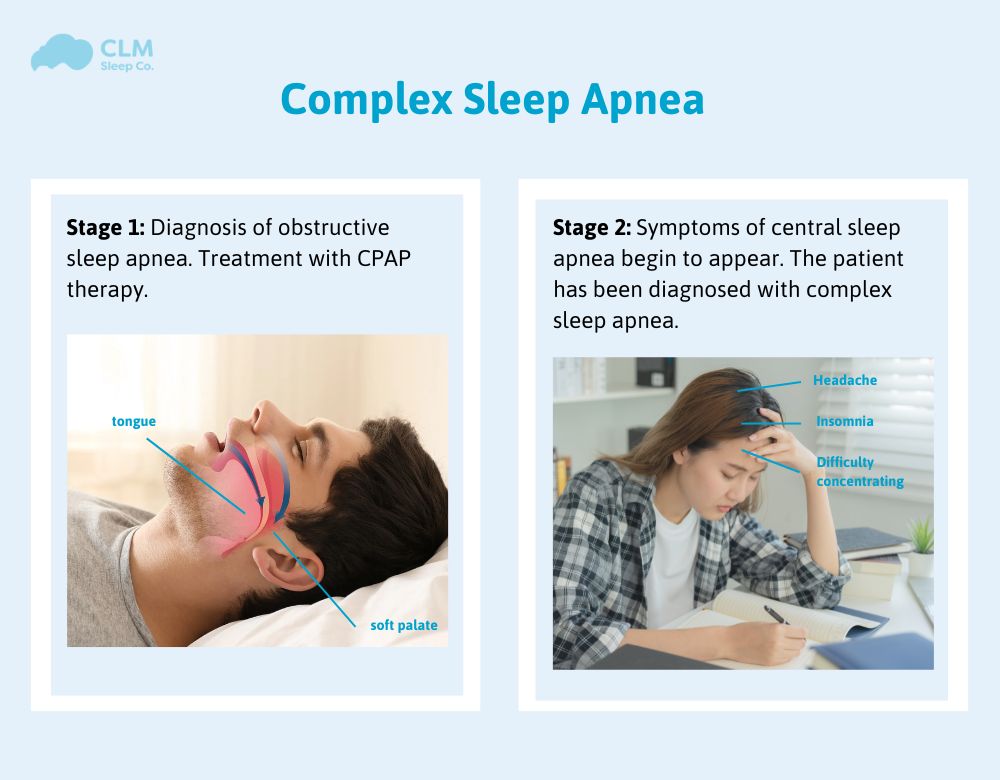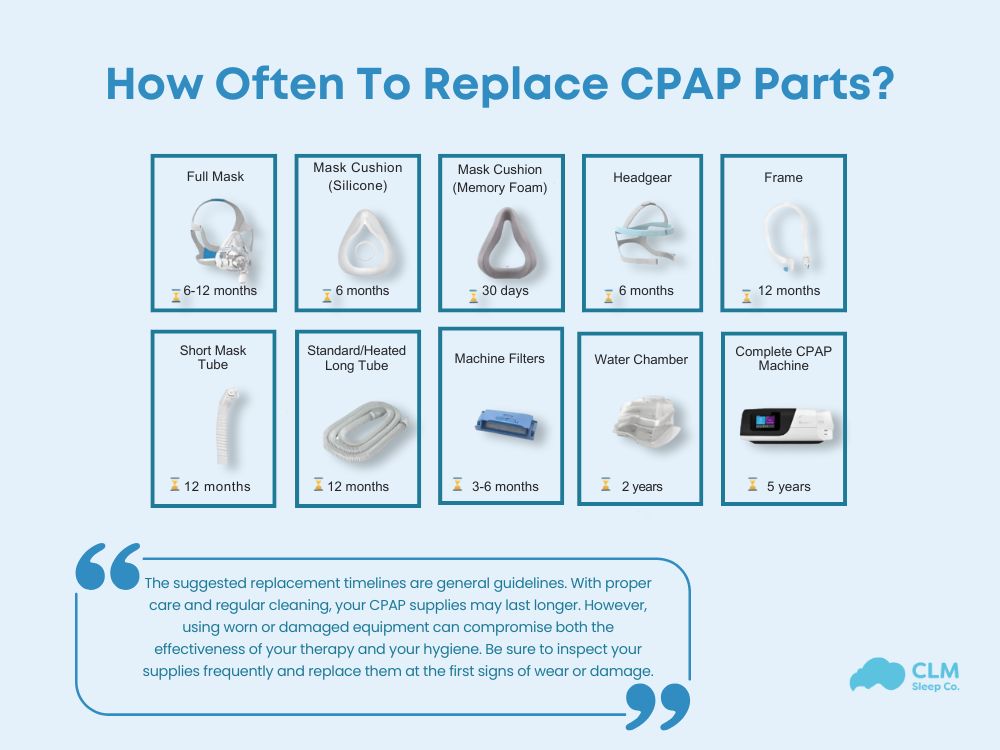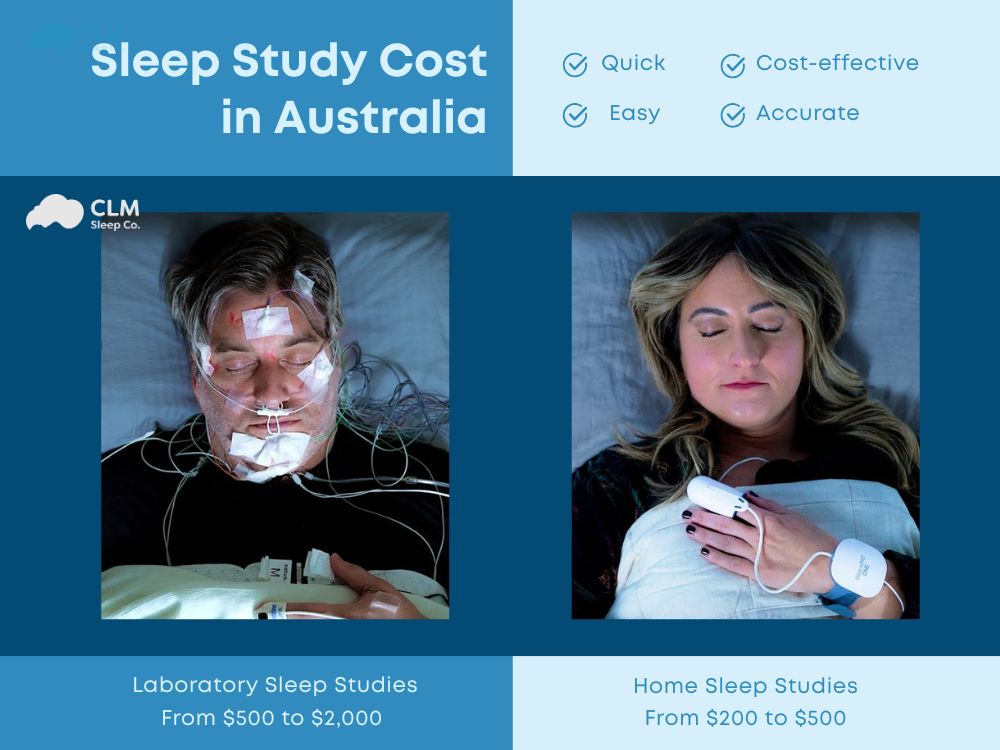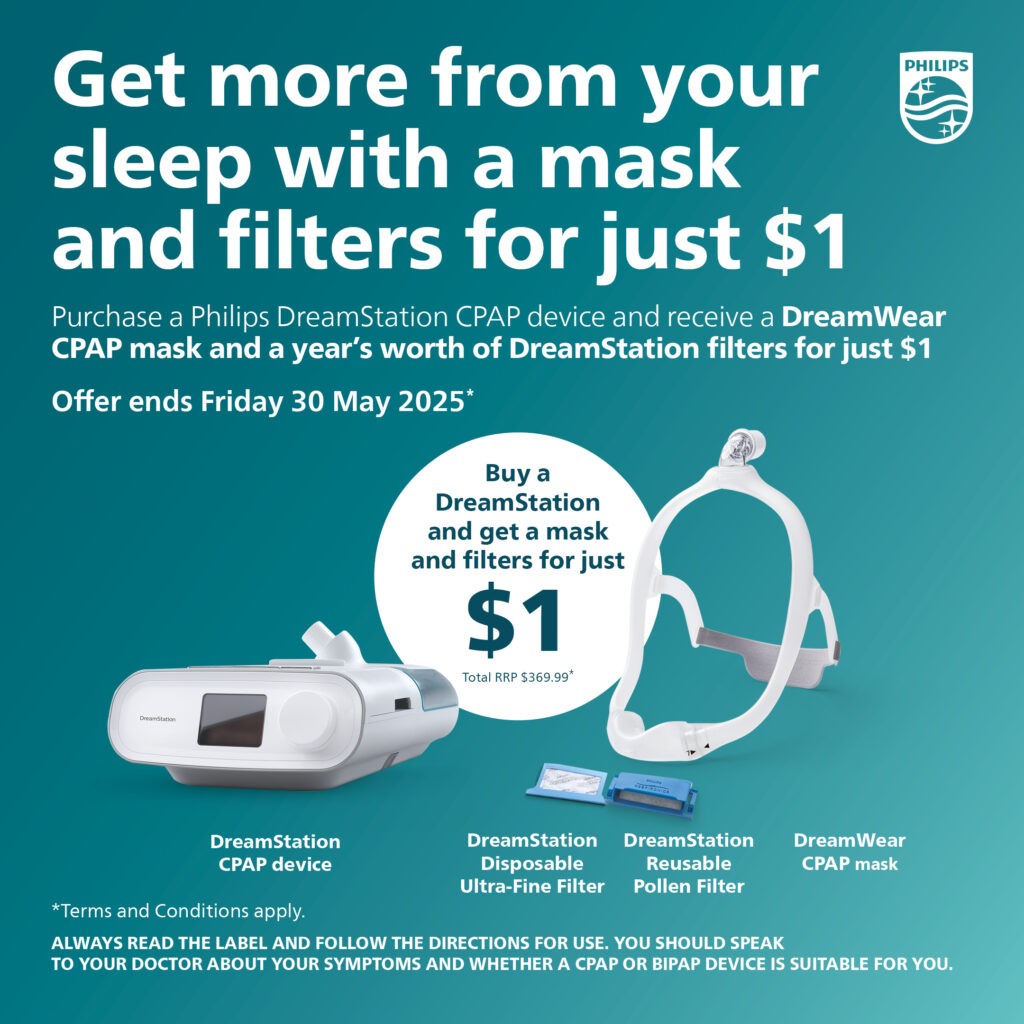Complex Sleep Apnea is a health issue that poses many risks, directly affecting the quality of sleep and the pulmonary and cardiac function of the patient. Recognizing and treating complex sleep apnea requires timely medical intervention, along with close monitoring. Therefore, to detect Complex Sleep Apnea early, you need to grasp the basic information about this condition. Let’s explore with CLM Sleep in the article below.
Complex Sleep Apnea Overview
Complex sleep apnea (CompSA), also known as central sleep apnea that occurs during treatment. It is a sleep disorder characterized by both obstructive sleep apnea (OSA) and central sleep apnea. (CSA). Initially, the patient will be diagnosed with obstructive sleep apnea. Subsequently, the condition progressed to Central Sleep Apnea while being treated with Continuous Positive Airway Pressure (CPAP) therapy. This will make the disease much more complicated and difficult to treat.
Obstructive sleep apnea (OSA) is a common sleep disorder in which breathing repeatedly stops and starts for a few seconds to a minute due to a physical blockage in the upper airway.
Central sleep apnea (CSA) is a less common type of sleep apnea that occurs when the brain does not send appropriate signals to the muscles that control breathing.
Is Complex Sleep Apnea the same as Mixed Sleep Apnea?
Complex Sleep Apnea (CompSA) and Mixed Sleep Apnea (MSA) are not exactly the same. Although both are related to the occurrence of obstructive apnea and central apnea events during sleep. But basically, there are still two different types of sleep apnea, each with its own treatment methods.
Difference Point
Complex Sleep Apnea is related to the occurrence of central sleep apnea (CSA) events after treating obstructive sleep apnea (OSA) events with CPAP therapy. It often occurs during the treatment process and requires the doctor to adjust the therapy.
Mixed Sleep Apnea is a type of apnea that combines both central and obstructive factors within a single event, not necessarily related to the treatment of OSA.
Prevalence of Complex Sleep Apnea
CompSA is estimated to occur in 5-15% of patients initially diagnosed with OSA and now receiving CPAP therapy. This disorder is diagnosed when central sleep apnea persists or develops despite therapy for obstructive sleep apnea. The following categories will have a higher prevalence of ComSA than other normal people.
Heart failure: Patients with heart failure may be more likely to develop CompSA because to Cheyne-Stokes Respiration (CSR), an unstable breathing rhythm. Simultaneously, the heart fails to efficiently pump blood, resulting in delays in relaying signals regarding CO2 and O2 levels to the brain, affecting respiratory regulation.
Older adults: This condition tends to be more common in older individuals due to a range of factors related to the aging process, physiological changes, and accompanying health conditions. Specifically, it is due to the decline of the central nervous system, which causes the respiratory regulation centers in the brain to become less sensitive, leading to episodes of apnea during sleep.
Male patient: Men often have a narrower and longer upper airway (including the nose, mouth, and throat), making it more susceptible to collapse or obstruction during sleep. At the same time, testosterone, the main hormone in males, also increases the risk of airway obstruction. Therefore, men are often more affected by CompSA than women.
High Altitude: People who live or sleep at high altitudes may be more likely to develop CompSA due to variations in oxygen levels, which influence breathing patterns.
Symptoms
Complex Sleep Apnea combines features of both Obstructive Sleep Apnea (OSA) and Central Sleep Apnea (CSA). As a result, the symptoms can vary but often include:
Loud Snoring: Like OSA, patients may have loud and disturbing snoring.
Observed Episodes of Apnea: Breathing pauses during sleep, noticed by a bed partner, which may be followed by gasping or choking sounds.
Excessive Daytime Sleepiness (Hypersomnia): Feeling excessively tired during the day, even after a full night’s sleep.
Difficulty Staying Asleep (Insomnia): Frequent awakenings during the night, often without any obvious cause.
Morning Headaches: Resulting from poor oxygenation during sleep.
Dry Mouth or Sore Throat Upon Waking: Due to breathing through the mouth.
Mood Changes: Irritability, depression, or anxiety due to fragmented sleep.
Difficulty Concentrating or Memory Problems: Cognitive issues stemming from sleep deprivation.
Frequent Urination at Night (Nocturia): Disrupted sleep may cause the body to produce more urine at night.
Shortness of Breath Upon Waking: A sensation of being unable to get enough air immediately upon waking.
When to see a doctor
Causes
The causes of complex sleep apnea is a combination of factors related to the initial obstruction and the development of central apnea components during CPAP Therapy. Here are some fundamental reasons:
CPAP-Induced CSA: Occurs as a result of increased breathing pressure, which causes instability in the breathing rhythm and leads to periods when the brain stops sending signals to breathe.
Sensitivity to Changes in Blood Gas Levels: For example, if a person breaths quickly while sleeping and their CO2 levels fall too low, the brain is forced to temporarily suspend the need to breathe, resulting in central apnea.
Heart Failure and Cheyne-Stokes Respiration (CSR): Patients with heart failure frequently demonstrate a respiratory pattern known as Cheyne-Stokes respiration, which consists of cycles of rapid breathing followed by periods
Nervous condition: Stroke, brain tumors, and other neurological illnesses affecting the brainstem (the part of the brain that regulates breathing) can all cause central sleep apnea.
Long-term use of sedatives: Weakens the central nervous system, impairing the brain’s ability to regulate breathing while sleeping and raising the risk of central apnea.
Age-related changes in respiratory control: Older persons have lower CO2 sensitivity and less consistent respiratory regulation, which may make them more vulnerable to both obstructive and central sleep apnea.
Gender: Males are more likely to suffer from both OSA and CompSA due to anatomical variations, hormone levels, and upper-body fat.
Risk factors
Here are the main risk factors for complex sleep apnea:
- Male Gender
- Older Age
- Smoking
- Obstructive Sleep Apnea (OSA)
- Heart Failure
- Stroke or Brain Injury
- Respiratory Instability
- Chronic Obstructive Pulmonary Disease (COPD): Atrial Fibrillation, Obesity, Diabetes, Chronic Kidney Disease (CKD)
Complex sleep apnea risk factors include demographic factors (such as age and gender), lifestyle factors (like smoking and obesity), medical conditions (such as heart failure and stroke), and medications (like opioids). Understanding these risk factors is critical for early diagnosis, prevention, and treatment of the disease.
Complications
Complications of complex sleep apnea can have a significant impact on one’s physical and emotional health. Here is specific information on possible complications:
Cardiovascular Issues
High blood pressure: Frequent episodes of breathlessness can cause high blood pressure, increasing the risk of developing chronic hypertension.
Heart failure: CompSA can aggravate existing heart failure or contribute to the onset of heart failure by putting additional strain on the heart caused by poor sleep and variable oxygen levels.
Arrhythmia: The abnormal breathing patterns and oxygen desaturation associated with CompSA can raise the risk of irregular heartbeats (arrhythmias), such as atrial fibrillation.
Stroke: Sleep apnea’s influence on cardiovascular health, including the potential for high blood pressure and arrhythmias, may raise the risk of stroke.
Metabolic Disorders
Type 2 Diabetes: Sleep apnea is linked to insulin resistance and glucose intolerance, which can contribute to the development or worsening of Type 2 diabetes.
Obesity: CompSA can worsen obesity or make it more difficult to manage weight due to the interplay between disrupted sleep and metabolic changes.
Respiratory Problems
Worsening of Chronic Obstructive Pulmonary Disease (COPD): Individuals with both COPD and CompSA may experience worsening respiratory symptoms and increased difficulty in managing their condition.
Pulmonary Hypertension: Increased pressure in the pulmonary arteries due to chronic low oxygen levels can lead to pulmonary hypertension.
Cognitive and Psychological Issues:
Daytime Sleepiness and Fatigue: Persistent daytime sleepiness and fatigue can affect daily functioning, impair work performance, and reduce quality of life.
Cognitive Impairment: Problems with concentration, memory, and overall cognitive function may arise from chronic sleep disruption.
Depression and Anxiety: CompSA can contribute to or worsen mood disorders such as depression and anxiety due to the impact of poor sleep quality and chronic health issues.
Increased Risk of Accidents
Motor Vehicle Accidents: Excessive daytime sleepiness increases the risk of drowsy driving, leading to a higher likelihood of motor vehicle accidents.
Occupational Accidents: Reduced alertness and concentration can lead to increased risk of accidents or errors at work.
Poor Treatment Outcomes
CPAP Therapy Ineffectiveness: If central apneas develop or persist during CPAP therapy for OSA, it may lead to suboptimal treatment outcomes and ongoing symptoms despite therapy.
Reduced Life Expectancy
Overall Health Impact: The cumulative effects of CompSA on cardiovascular, metabolic, respiratory, and cognitive health can contribute to a reduced life expectancy.
Difficulties in Managing Existing Conditions
Complications with Other Medical Conditions: CompSA can complicate the management of other chronic conditions such as heart disease, diabetes, and kidney disease.
Diagnosis and Test
Diagnosing Complex Sleep Apnea (CompSA) requires a thorough evaluation by a healthcare provider, often a sleep specialist. The process typically includes a detailed medical history, physical examination, and specific diagnostic tests to differentiate between obstructive sleep apnea (OSA), central sleep apnea (CSA), and CompSA. Here is an overview of the diagnostic process:
Medical History and Symptom Evaluation
Detailed Symptom Assessment: The doctor will ask about symptoms such as snoring, observed pauses in breathing, daytime sleepiness, fatigue, insomnia, morning headaches, and mood changes. They may also inquire about any history of cardiovascular or neurological conditions, medications, lifestyle factors (e.g., smoking, alcohol use), and any other health conditions that might contribute to sleep apnea.
Previous Sleep Apnea Diagnosis: Understanding if the patient has a history of obstructive sleep apnea (OSA) or has been undergoing treatment (like CPAP therapy) is essential, as CompSA often emerges in patients already being treated for OSA.
Physical Examination
Examine Physical Traits: The doctor may check for physical characteristics associated with sleep apnea, such as a large neck circumference, nasal obstruction, enlarged tonsils, or a crowded oropharynx.
Cardiovascular and Neurological Evaluation: Checking for signs of heart failure, atrial fibrillation, or neurological disorders that may predispose someone to central sleep apnea.
Diagnostic Testing
The gold standard for diagnosing CompSA is an overnight sleep study or polysomnography. This can be performed in a sleep laboratory (in-lab polysomnography) or at home using portable monitoring equipment, depending on the patient’s condition and the severity of symptoms.
Polysomnography (Sleep Study)
In-Lab Polysomnography
This is the most comprehensive test and is usually recommended when diagnosing CompSA. It involves an overnight stay in a sleep laboratory, where a wide range of physiological parameters is monitored, including:
Electroencephalography (EEG): To measure brain activity and determine different stages of sleep.
Electrooculography (EOG): To track eye movements, which helps in identifying REM and non-REM sleep.
Electromyography (EMG): To measure muscle activity, especially in the chin and legs, to detect muscle tone during sleep.
Electrocardiography (ECG): To monitor heart rate and rhythm.
Respiratory Effort Sensors: To measure chest and abdominal movements, which help differentiate between obstructive and central apneas.
Airflow Sensors: To monitor airflow at the nose and mouth, detecting pauses in breathing.
Pulse Oximetry: To measure blood oxygen levels.
Snore Microphone: To record snoring sounds.
Results Analysis:
The sleep study results will show the number and type of apneas (obstructive or central), hypopneas, and the apnea-hypopnea index (AHI), which measures the severity of the condition.
Diagnosis of CompSA: CompSA is diagnosed when central apneas persist or appear during CPAP therapy for OSA, and the central apneas make up a significant portion of the total apneas (>5 central apneas per hour).
Home Sleep Apnea Test (HSAT)
Home-Based Testing
A less comprehensive alternative to in-lab polysomnography. It uses portable devices to monitor airflow, respiratory effort, and blood oxygen levels while the patient sleeps at home.
May be used for initial assessment, but if CompSA is suspected, an in-lab polysomnography is generally required for a definitive diagnosis.
Follow-Up Testing
CPAP Titration Study:
If a patient with OSA begins CPAP therapy and central apneas emerge, a CPAP titration study might be conducted. This involves adjusting the pressure settings to determine the optimal level for minimizing both obstructive and central events.
Adaptive Servo-Ventilation (ASV) Titration Study:
For patients diagnosed with CompSA, a titration study with adaptive servo-ventilation (ASV) devices may be performed to determine the best settings. ASV devices automatically adjust pressure levels to stabilize breathing patterns and reduce both obstructive and central apneas.
Additional Evaluations
Blood Tests
To rule out conditions that may contribute to sleep apnea, such as thyroid dysfunction (hypothyroidism) or electrolyte imbalances.
Cardiovascular Assessment
An echocardiogram or other cardiac evaluations may be performed if heart failure or other cardiovascular conditions are suspected as contributing factors.
Neurological Assessment
If a neurological cause is suspected (such as a prior stroke or brainstem injury), a brain MRI or CT scan may be necessary to assess for any underlying conditions that could be contributing to CompSA.
The diagnosis of Complex Sleep Apnea involves a combination of medical history, physical examination, and comprehensive sleep studies. Polysomnography is the key diagnostic tool, especially when central apneas develop or persist during CPAP therapy
What specific criteria and figures?
How to complex sleep apnea test at home
Management and Treatment
Managing and treating Complex Sleep Apnea (CompSA) involves a tailored approach that addresses both obstructive and central components of the condition. Since CompSA often emerges during the treatment of Obstructive Sleep Apnea (OSA) with Continuous Positive Airway Pressure (CPAP) therapy, treatment strategies are focused on optimizing therapy, reducing central apneas, and addressing any underlying medical conditions. Here is a comprehensive overview of management and treatment options:
Optimizing Positive Airway Pressure (PAP) Therapy
CPAP Therapy Adjustment
Continue and Monitor CPAP: Initially, CPAP therapy may be continued while closely monitoring the patient to see if central apneas resolve over time. Sometimes, central apneas that appear with CPAP use are temporary and resolve as the body adapts to the therapy.
Pressure Adjustments: Adjusting the pressure settings of the CPAP machine may help reduce the occurrence of central apneas. This can involve lowering the pressure to minimize overventilation or altering the pressure settings to a more comfortable level for the patient.
Bilevel Positive Airway Pressure (BiPAP): If CPAP adjustments do not reduce central apneas, Bilevel Positive Airway Pressure (BiPAP) may be used. BiPAP provides different levels of pressure for inhalation (IPAP) and exhalation (EPAP), which can help improve ventilation and reduce central apneas in some cases.
Adaptive Servo-Ventilation (ASV)
Primary Treatment for CompSA: ASV is considered the gold standard treatment for CompSA. It is a specialized form of positive airway pressure therapy designed to automatically adjust the pressure to stabilize breathing patterns.
How It Works: ASV continuously monitors the patient’s breathing and adjusts the pressure support dynamically to counteract both obstructive and central apneas. It provides higher pressure during periods of low breathing effort (central apnea) and lower pressure during normal breathing.
Contraindications: ASV may not be suitable for patients with certain types of heart failure (especially those with reduced ejection fraction <45%) due to an increased risk of mortality.
Addressing Underlying Medical Conditions
Heart Failure Management
For patients with heart failure, optimizing treatment for the heart condition is crucial. This can include medications (such as ACE inhibitors, beta-blockers, or diuretics), lifestyle changes, or surgical interventions.
Monitoring Fluid Balance: Managing fluid retention through diuretics or dietary changes (like reducing salt intake) can help reduce the occurrence of central apneas.
Management of Neurological Conditions: For patients with a history of stroke or other neurological conditions, managing the underlying neurological disorder is essential. This may involve medications, physical therapy, or surgical interventions.
Reducing Opioid Use:If central sleep apnea is associated with opioid use, reducing or discontinuing opioid medications may help alleviate the condition. This should be done under medical supervision to avoid withdrawal and ensure patient safety.
Supplemental Oxygen TherapyOxygen Supplementation
Providing supplemental oxygen during sleep may help reduce the frequency of central apneas by stabilizing oxygen levels. This approach is often used when other treatments are not fully effective or in patients who cannot tolerate PAP therapy.
Medications
Acetazolamide: A medication that can stimulate breathing by inducing a mild metabolic acidosis, thereby increasing respiratory drive. It is sometimes used in patients with central sleep apnea, particularly at high altitudes or when other treatments are not effective.
Theophylline: A respiratory stimulant that may be used in some cases, although its use is limited due to potential side effects like heart palpitations and gastrointestinal discomfort.
Sedative Hypnotics (e.g., Zolpidem, Eszopiclone)In select cases, sedatives may be used to stabilize sleep patterns and reduce arousals that can trigger central apneas. However, this approach is typically used with caution due to the risk of worsening apneas in some patients.
Lifestyle Modifications
Weight Management: Weight loss through diet, exercise, or surgical interventions (like bariatric surgery) can help reduce both obstructive and central apneas. Obesity is a major risk factor for sleep apnea, and weight reduction can significantly improve symptoms.
Sleep Positioning: Avoiding sleeping on the back (supine position) may help reduce obstructive apneas. Positional therapy, such as using a special pillow or a positional device, may help maintain a side-sleeping position. Avoidance of Alcohol and Sedatives: Reducing or eliminating alcohol and sedative use, especially before bedtime, can help decrease the frequency of apneas and improve overall sleep quality.
Patient Education and Support
Sleep Hygiene Education
Educating patients about good sleep hygiene practices, such as maintaining a regular sleep schedule, creating a comfortable sleep environment, and avoiding caffeine and electronic screens before bedtime, can help improve overall sleep quality.
Psychological Support
Addressing any psychological issues, such as anxiety or depression, that may arise from living with a chronic condition like CompSA. Counseling, cognitive behavioral therapy (CBT), or support groups may be beneficial.
Monitoring and Follow-Up
Regular Follow-Up Visits: Ongoing follow-up with a sleep specialist is crucial to monitor treatment effectiveness, adjust therapy as needed, and ensure optimal management of any underlying conditions.
Repeat Sleep Studies: Periodic sleep studies may be recommended to assess the effectiveness of treatment and make any necessary adjustments to the therapy plan.
Management and treatment of Complex Sleep Apnea involve a comprehensive approach that combines optimizing PAP therapy, managing underlying medical conditions, potentially using medications or supplemental oxygen, and encouraging lifestyle changes. ASV is often the preferred treatment for CompSA, but individualized care based on the patient’s specific needs and health status is essential for effective management.
Departments that treat complex sleep apnea
Many medical departments and specialties can participate in the diagnosis, treatment, and management of complex sleep apnea. (CompSA). CompSA requires a multidisciplinary approach to address both OSA and CSA. As well as any underlying conditions that contribute to its development. Here are the main departments and specialties involved:
Pulmonology (Respiratory Medicine)
Role: Pulmonologists specialize in diagnosing and treating respiratory disorders, including various types of sleep apnea.
Services: They often manage patients with sleep-disordered breathing, provide PAP therapy (such as CPAP, BiPAP, or ASV), and monitor treatment effectiveness. They may also address underlying pulmonary conditions like Chronic Obstructive Pulmonary Disease (COPD) that can contribute to CompSA.
Sleep Medicine
Role: Sleep specialists, often board-certified in sleep medicine, are the primary providers for diagnosing and treating sleep disorders, including CompSA.
Services: They perform and interpret sleep studies (polysomnography), prescribe PAP therapy, and provide a comprehensive treatment plan tailored to the patient’s needs. Sleep medicine specialists are crucial in monitoring patients for treatment adherence and efficacy.
Cardiology
Role: Cardiologists manage cardiovascular conditions that are often associated with or can exacerbate CompSA. Such as heart failure, atrial fibrillation, and hypertension.
Services: They may perform diagnostic tests like echocardiograms or stress tests. Prescribe medications to optimize heart function. And collaborate with sleep specialists to adjust treatment plans for patients with concurrent cardiac issues.
Neurology
Role: Neurologists are involved in cases where neurological conditions. Such as stroke, brain injury, or neurodegenerative diseases, contribute to the development of central sleep apnea and CompSA.
Services: They assess and manage the underlying neurological conditions, provide interventions. To stabilize breathing, and may work with sleep specialists to tailor treatment strategies.
Otolaryngology (ENT – Ear, Nose, and Throat)
Role: ENT specialists may address anatomical issues contributing to airway obstruction in sleep apnea. Such as enlarged tonsils, nasal obstruction, or structural abnormalities in the upper airway.
Services: They may perform surgeries like uvulopalatopharyngoplasty (UPPP), septoplasty, or tonsillectomy. To reduce airway obstruction, which can help alleviate the obstructive component of CompSA.
Conclusion
The management of Complex Sleep Apnea often involves a multidisciplinary team. Includes pulmonologists, sleep medicine specialists, cardiologists, neurologists, and other healthcare providers, depending on the individual patient’s needs. This comprehensive approach ensures that all underlying conditions are addressed, and the most effective treatment strategy is developed.





